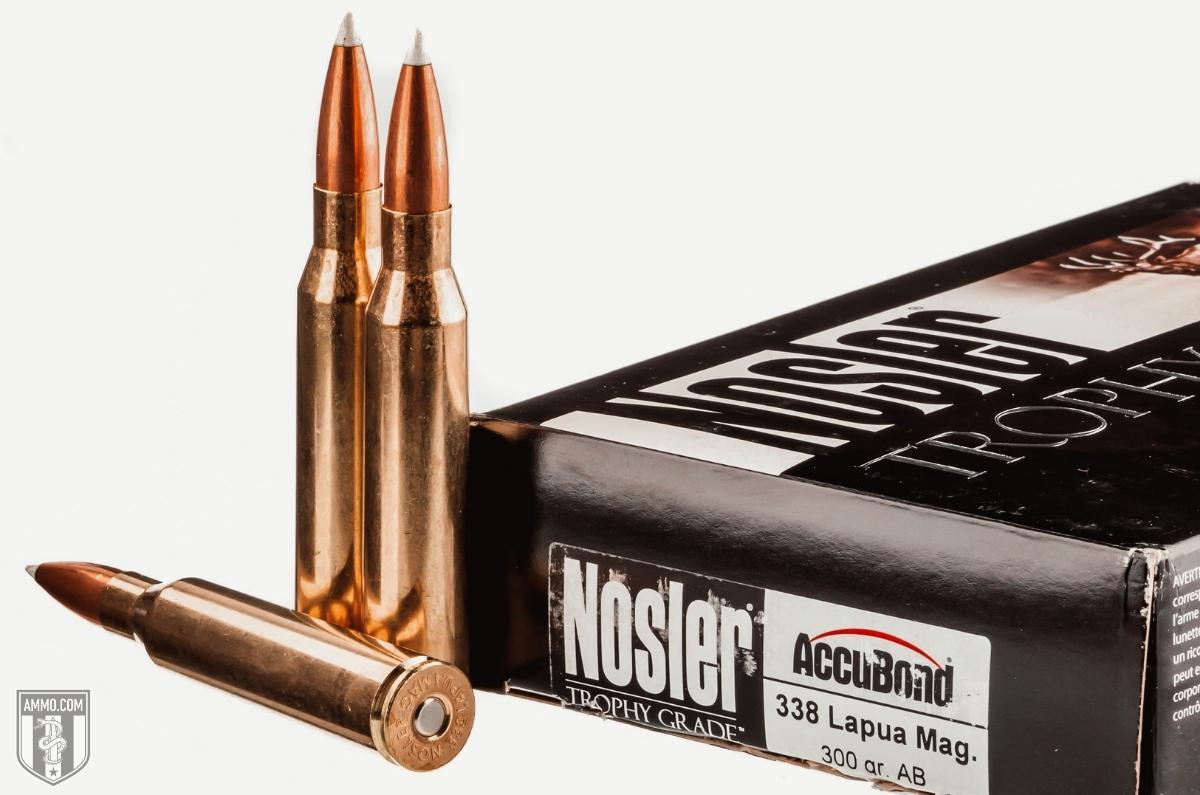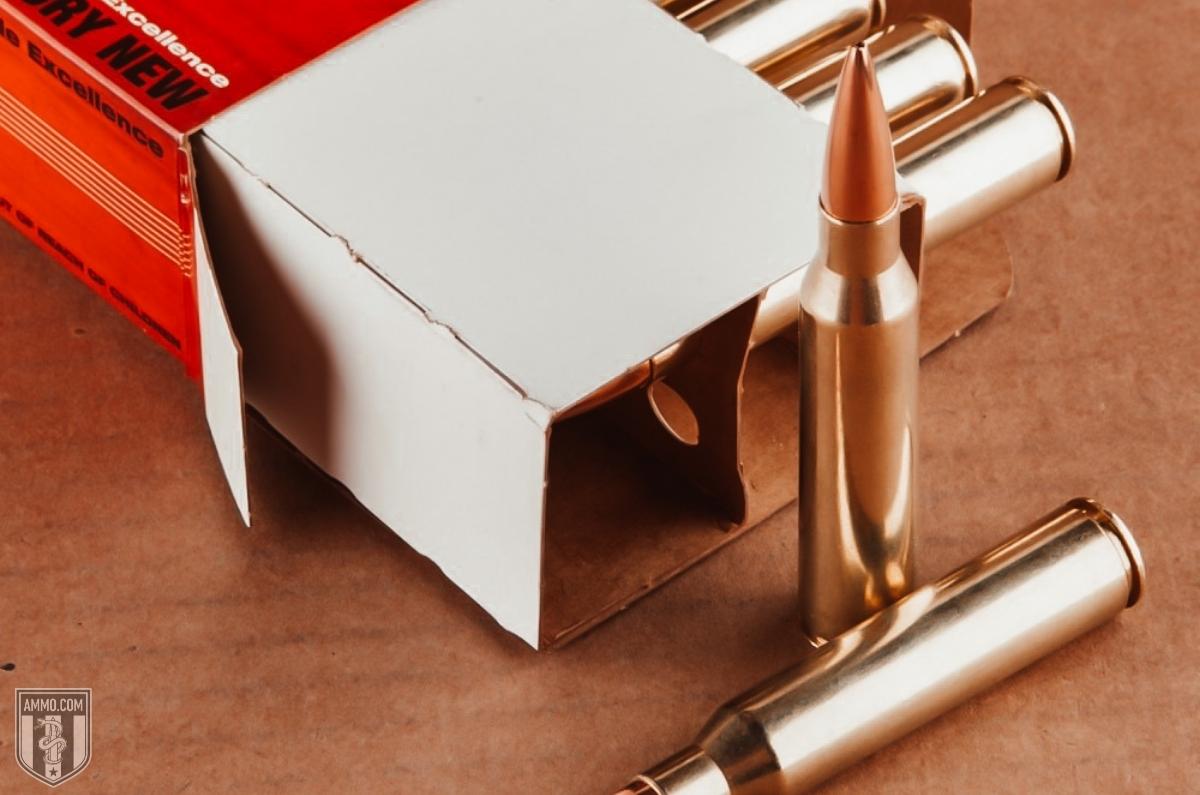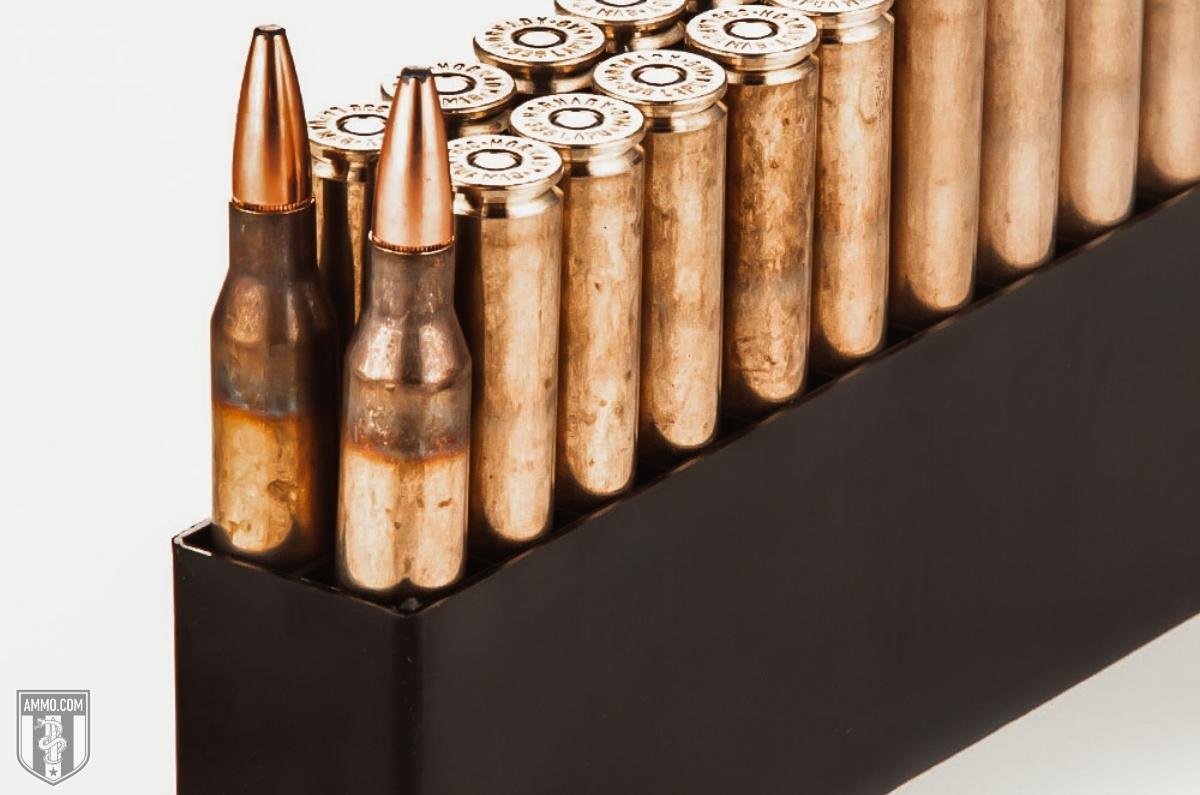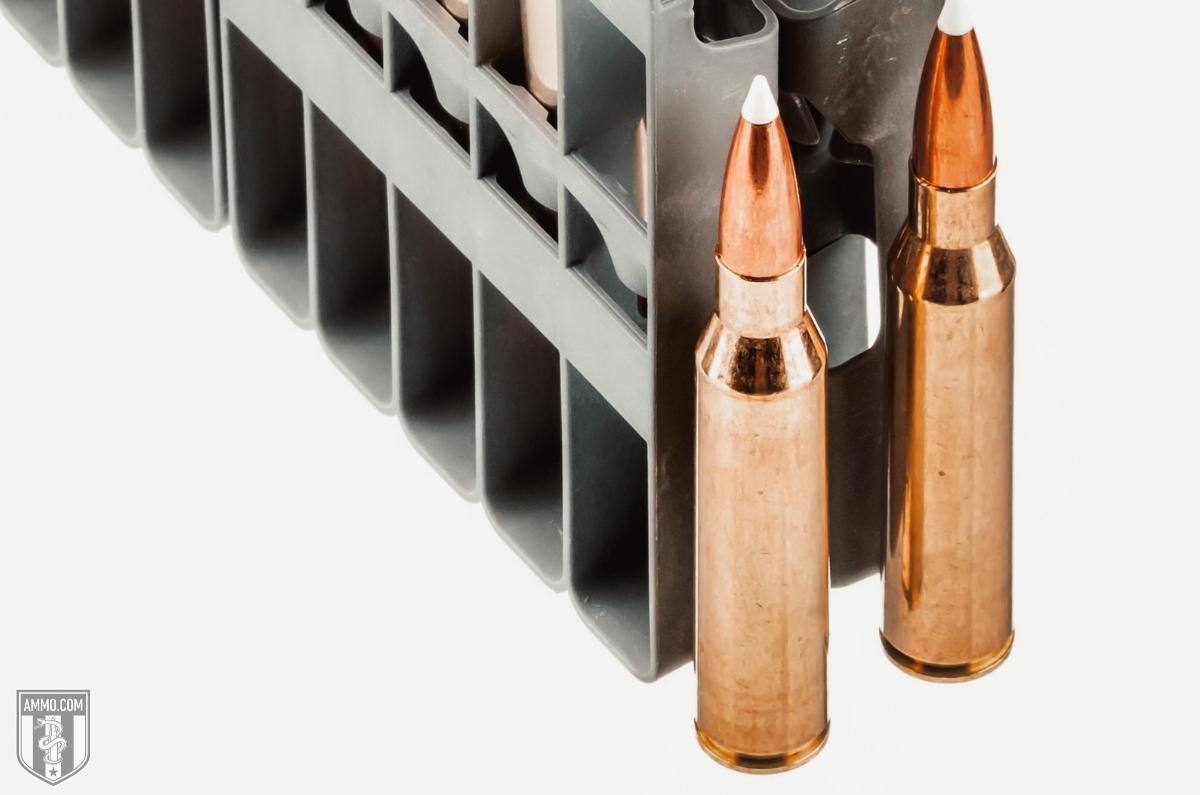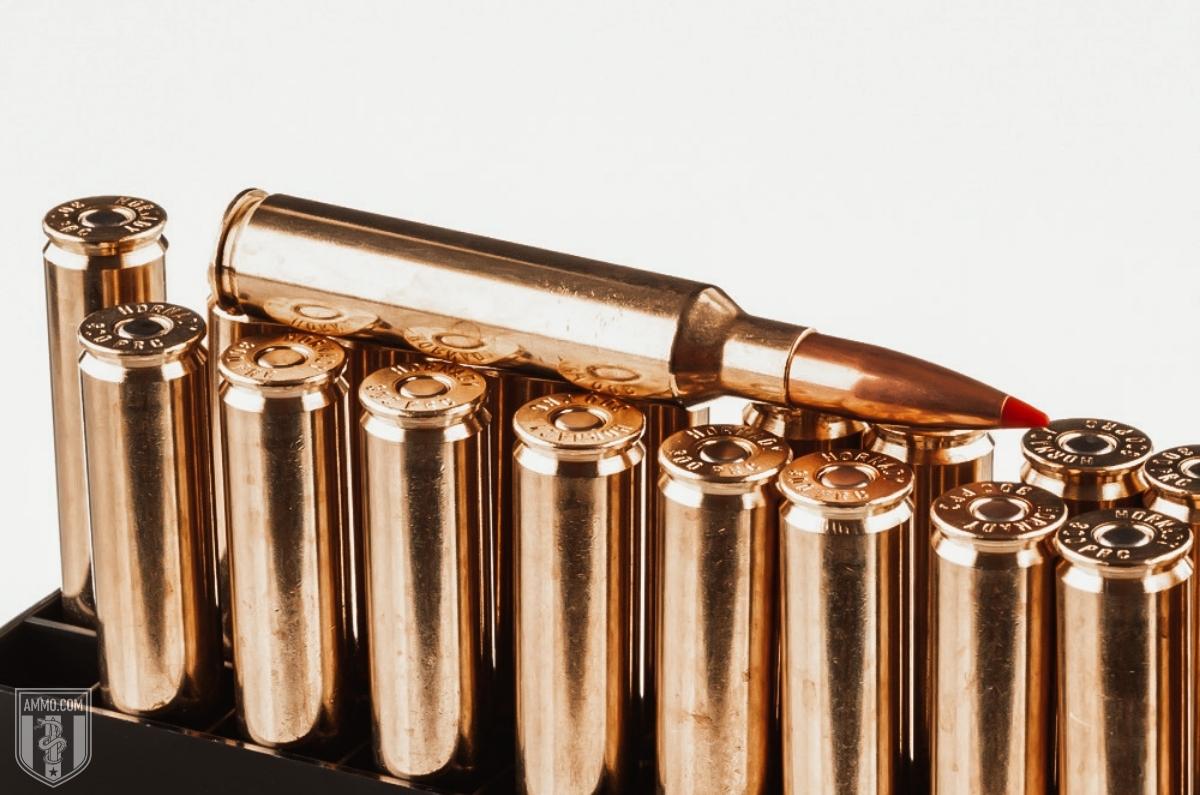300 PRC vs 338 Lapua: Long Range Shooters Rejoice
 Unless you keep a watchful eye on or participate in long-range shooting, you likely missed the introduction of the Hornady .300 PRC (Precision Rifle Cartridge) in 2018. Hornady designed the 300 PRC to be the ideal 30-caliber magnum for long-range precision rifle competition. And when we say “long-range” we are talking 1,500 yards at a minimum.
Unless you keep a watchful eye on or participate in long-range shooting, you likely missed the introduction of the Hornady .300 PRC (Precision Rifle Cartridge) in 2018. Hornady designed the 300 PRC to be the ideal 30-caliber magnum for long-range precision rifle competition. And when we say “long-range” we are talking 1,500 yards at a minimum.
In the past, if you wanted to shoot that far, you needed to employ the use of the heavy-hitting 338 Lapua Magnum and all its shoulder bruising recoil that it imparts on its victims…err…shooters.
The 338 Lapua Mag was designed to punch through military-grade body armor at 1,000 yards and currently holds the #3 and #10 positions on the ten longest sniper rifle shots in history.
Both rifle cartridges were designed for ELR (Extra Long Range) shooting, but which one is going to be the best option for you? In this article, we will compare the new kid on the block, the 300 PRC, against the military long-range mainstay, the 338 Lapua.
Understand the Difference Between 300 PRC vs 338 Lapua
The 300 PRC and 338 Lapua Mag were designed with one concept in mind: long-range performance.
Both cartridges were designed to fire long, aerodynamic bullets with a ridiculously high ballistic coefficient to make wind drift a mere afterthought. This allows skilled marksmen to maintain MOA (minute of angle) accuracy at ranges up to and over 1,500 yards.
The 338 Lapua provides long-distance shooters amazing terminal ballistics, trajectory, and accuracy, but it does so at the cost of punishing recoil.
Enter the .300 Hornady PRC, which can do everything the 338 can do under 1,500 yards with less recoil.
Ever since the widespread success of the 30-06 Springfield and 308 Winchester, American ammo manufacturers have been working to perfect 0.308” caliber bullets.
And when it comes to 30-caliber magnum cartridges, you have a crazy number of options. Some of the most popular are the 300 Winchester Magnum, 30 Nosler, 300 Weatherby Magnum, 300 Norma Magnum, and 300 Remington Ultra Magnum, just to name a few.
With so many options it begs the question, “What makes the 300 PRC any better than any other 30-cal on the market?”
Although most of the cartridges on that list can shoot ELR, such as the 300 Win Mag and 300 Norma, the 300 PRC was specifically designed and optimized for this purpose.
But is it worth ditching your 300 Winchester Magnum or 6.5 Creedmoor bolt-action hunting rifle to get a 300 PRC? Or is the 338 Lapua the better option?
In the following sections, we will break down the positive and negative aspects of both the 300 PRC and 338 Lapua.
Cartridge Specs
When comparing precision rifle cartridges, it’s a good idea to compare the cartridge specs to gain more knowledge of each.
Descended from the 375 Ruger, the 300 PRC sports a 0.532” base diameter meaning that it requires a full magnum bolt face just like the 338. Furthermore, the 300 PRC has an extremely long overall length of 3.7” meaning that it requires a magnum action rifle and a longer bolt throw to allow for reliable feeding.
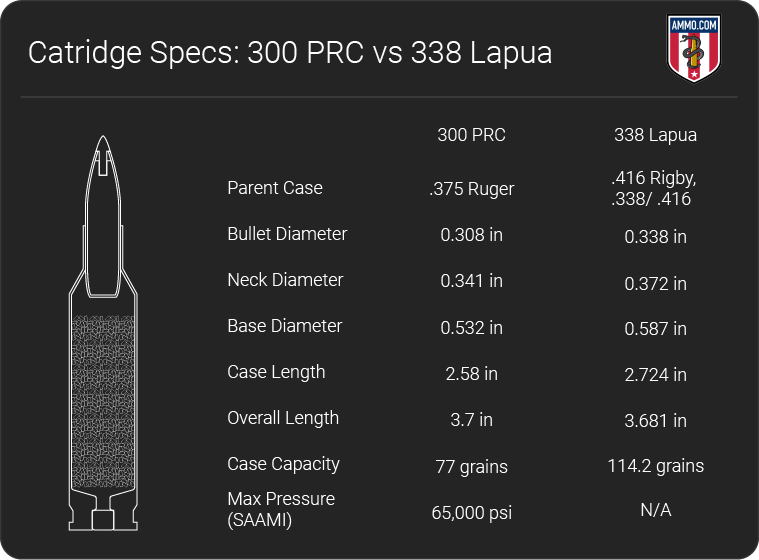
Using a long action, like that used for the 30-06 Springfield or 300 Winchester Magnum, would mean that the 300 PRC bullets would enter the chamber at too severe of an angle, causing a jam.
Hornady specifically designed the 300 PRC for the magnum action as they wanted their cartridge to have as long a “head height” as possible. Head height is simply the overall length minus the case length. A longer head height allows for longer, more aerodynamic projectiles with a higher ballistic coefficient (BC) to be used.
A high BC is preferred when shooting long-range and the 1.12” head height of the 300 PRC allows for this. Furthermore, it allows more of the case capacity utilization for extremely high loads.
Speaking of case capacity, this is one area where the 338 Lapua and 300 PRC differ considerably. The 338 Lapua can handle a whopping 114 gr of propellant while the 300 PRC can handle 77 gr loads of powder.
One interesting difference is that the 300 PRC has a slightly longer overall length than the 338 (3.7” vs 3.681”). Though this is a minor difference, it shows the lengths that Hornady went to make the 300 PRC accept extremely long projectiles that are ideal for long-range shooting.
At the time of writing, SAAMI has not proofed the 338 Lapua and does not have an established max pressure for the round. To complicate matters, Lapua and the CIP have been somewhat ambivalent about the max pressure for the cartridge.
There is some scholarly debate as to the max pressure for the 338 Lapua, but the lower limits (and therefore safer) suggest 420 MPa (60,916 PSI). The maximum pressure for 300 PRC based on SAAMI specs is 65,000 psi, making it the higher-pressure round.
However, all that powder, pressure, and heavier bullets have two major drawbacks: recoil and barrel life.
Recoil
Neither the 300 PRC nor the 338 Lapua are a slouch when it comes to recoil. The primary factors to consider when talking about recoil are the weight of the rifle and bullet weight being fired at a given muzzle velocity.
For this comparison, we will consider the Barrett MRAD bolt-action rifle, weighing 14.5 lbs. For bullet selection, we will use the 300 PRC 225 gr Hornady ELD Match (ELD-M) traveling at 2810 fps. For the 338, we will use the 250 gr LockBase projectiles fired at 3000 fps. Both are factory loads from Hornady and Lapua, respectively.
With these variables set, we see that felt recoil for the 300 PRC is around 22 ft-lbs of force compared to 38 ft-lbs of felt recoil for the 338. That’s about a 70% difference!
Less recoil typically corresponds to increased downrange accuracy as there is less chance for a shooter to jerk the trigger due to recoil anticipation. This is why lower recoiling cartridges are preferred for long-distance shooting like the 6.5 Creedmoor, and now the 300 PRC.
A muzzle brake can be used for both cartridges to tame recoil further, but the 300 PRC will have less recoil regardless.
Barrel Life
Barrel life is a tricky thing to track as it will vary greatly based on the barrel manufacturer and the powder charge being used in the rifle.
Precision rifle shooters who routinely work at ranges at or above 1,500 yards will meticulously track their barrel life as they demand the pinnacle of performance and accuracy. However, the loads that they are using will typically affect barrel life the most.
A maximum load will always put added wear and tear on any barrel and reduce its lifespan. However, there’s not a lot of data out there for either cartridge to establish what the accepted barrel life is. However, from what I was able to find, both the 338 and 300 PRC have about a 1,500 round barrel life assuming you are not redlining the muzzle velocity and pressure.
Trajectory
Trajectory is how we quantify a bullet’s flight path as it travels downrange measured in inches of bullet drop.
Both the 338 and 300 PRC were designed for ELR precision rifle shooting, as such, they both have amazing trajectories. Even with factory ammo that’s tuned for match shooting, reaching out to 1,500 yards is achievable for both cartridges.
Bullet weight and muzzle velocity both play a role in determining trajectory, so for this comparison, we will compare the 338 Lapua Hornady 250-grain ELD-M and the 300 PRC 225 grain ELD-M.
Using Hornady’s Ballistic Calculator, we can determine that the 338 will have -804” of bullet drop at 1,500 yards while the 300 PRC is at -776”.
This means that the 300 PRC will have a flatter trajectory and therefore require less scope adjustment to remain on target than the 338 Lapua (for the rounds analyzed).
There are other projectiles available for both cartridges from manufacturers like Berger, Sierra, Hornady, and Norma that have excellent long-range performance as well. These bullets can affect the trajectory of the round due to differences in their ballistic coefficient, bullet weight, and profile.
However, in general, the 300 PRC will have a flatter trajectory.
Accuracy
Accuracy is a tricky category to empirically analyze as there are factors that cannot be calculated. The rifle system being used, barrel life, consistency of ammo, the skill of the shooter, and environmental conditions all play a part in accuracy.
All things being equal, both the 338 and the 300 PRC are extremely accurate within their effective ranges and sub-MOA accuracy is achievable with match-grade ammo, proper optics, and proper execution of the fundamentals of marksmanship.
However, things are rarely equal when it comes to shooting long distance. And most marksmen will state that they are more accurate with the 300 PRC due to its flatter trajectory and lower recoil impulse.
Ballistic Coefficient
Ballistic coefficient (BC) is a measure of how well a bullet resists wind and air resistance. Put another way, it’s a numeric representation of how aerodynamic a bullet is. A high BC is preferred as this means the bullet will buck the wind easier.
Generally, a heavier bullet will have a higher BC as it takes more force to disrupt the flight of a heavier bullet than a lighter one.
With that in mind, it would be easier to think that the 338 had high BC bullets, more so than 300 PRC. And you would be correct in this line of thinking, as the 338 has access to heavier bullets.
However, the 300 PRC has some of the highest ballistic coefficients you can find for a 30-caliber magnum cartridge. The 250 gr A-Tip Hornady Match has a BC of 0.878 while the 225 gr ELD Match has a respectable 0.777 BC. Barnes also has several offerings, the best being the 245 gr Extreme Outer Limits with a BC of 0.807.
For 338 Lapua, the Hornady 300 gr A-Tip Match has a BC of 0.863 while the Berger 300 gr Hybrid OTM clocks in with a BC of 0.822.
Sectional Density
Sectional Density (SD) is the measure of how well a bullet penetrates a target. This is extremely important when hunting big game, as you need a bullet that can punch through thick hide, bone, and sinew.
Sectional density is calculated by comparing the bullet weight and the bullet diameter. The higher the SD the deeper the bullet will penetrate the target.
Both cartridges have exceptional sectional density values; however, the 300 PRC will penetrate deeper and therefore have a higher SD. The reason for this is that the smaller 30-caliber bullet will localize all its force on a smaller surface area. This leads to more kinetic energy being focused into a smaller area, resulting in deeper penetration.
Hunting
When picking your next hunting rifle, caliber selection is an important part of the process. Both the 338 Lapua and 300 PRC are excellent for long-range hunting, but the Hornady .300 PRC is clearly the better choice.
With a similar trajectory to 338, it offers exceptional stopping power at considerably less recoil. The Hornady 212 gr and 220 grain ELD-X line offer exceptional expansion even at a very long range.
The 300 PRC is more than enough to take down any game animal in North America and will be extremely effective against African game except for elephants, rhinos, and cape buffalo. For very large African game the 338 would be the better option, but it is overkill for most North American game.
Ammo and Rifle Price/Availability
When it comes to shooting 338 or 300 PRC, I hope that you have deep pockets because long-range target shooting isn’t cheap.
Most tactical rifles for 300 PRC are going to run you around $2,000 at the time of writing. Brands like Bergara and the Ruger Precision Rifle will be your less expensive options with brands like Barrett, GA Precision, and the Remington Custom Shop costing considerably more.
As 338 has been around since the 1980s, there are more hunting rifle options available for this chambering. Remington, Savage, and Ruger have options available in 338 Lapua, but do not expect to drop anything less than a grand on a bolt action rifle. If you’re looking for a tactical bolt-action rifle like a Barrett MRAD or Accuracy International AXMC you should plan to spend nothing less than $4,000 after it’s all said and done.
Factory ammo cost is another issue to discuss as shooting both rifle cartridges is very expensive. The absolute cheapest 338 Lapua fmj practice ammo that I could find on the Internet was checking in at about $4.45/round (and you had to buy a 200 round case to get this reduced price). Hunting ammo for 338 will run you no less than $8/round with match-grade options in the $10/round realm or higher.
Although the 300 PRC is still expensive to shoot, it is a little less than 338. The cheapest 300 ammo I could find ran around $3/round while match ammo ran around $6-7/round.
The issue with 300 PRC is that there are not many bullet weights available currently. The 212 gr and 220 grain ELD-X line from Hornady are the most popular factory loads while the 225 grain ELD-M is a close third. And that’s about it!
For 338 Lapua, you have considerably more manufacturers and bullet weight options available.
Reloading
Reloading is one way to soften the impact of purchasing ammo for both the 338 and 300 PRC. Handloaders enjoy creating their own custom loads to squeeze every grain and fps of performance out of both cartridges.
Reloading has a higher up-front cost as you need to purchase the presses and dies required to prepare the brass cases for loading. However, that expense is quickly recouped in the 20-40% cost reduction per round that handloaders enjoy.
Furthermore, the ability to customize your ammo to your bolt-action rifle is something that match-grade factory ammo simply cannot do.
Although the 300 PRC can shoot lighter 30-caliber bullets, it is not as effective at doing so as the 300 Winchester Magnum, 30 Nosler, 300 Weatherby Magnum, and 300 WSM. This means that bullets that you purchase for reloading 300 PRC will typically be reserved for those cases except for potentially 300 Norma Magnum and 300 Rem Ultra Mag.
All the major bullet manufacturers like Hornady, Nosler, Sierra, and Berger have options in both heavyweight 30-caliber and 338-caliber bullets.
For 300 PRC, the most common bullet weights are 212, 220, 225, and 250 grains. For 338, the 250, 270, and 300 grain bullets are the easiest to find.
Ballistics
Our team here at Ammo.com has spent countless hours scouring the Internet to bring you extremely comprehensive ballistics tables for both calibers. These tables will compare bullet weight to muzzle velocity, muzzle energy, and trajectory.
338 Lapua Mag Ballistics
| 338 Lapua Magnum Bullet WEIGHT | Muzzle VELOCITY (fps) | Muzzle ENERGY (ft. lbs.) | TRAJECTORY (in.) | |||||||||||
|---|---|---|---|---|---|---|---|---|---|---|---|---|---|---|
| Muzzle | 100 yds. | 200 yds. | 300 yds. | 400 yds. | Muzzle | 100 yds. | 200 yds. | 300 yds. | 400 yds. | 100 yds. | 200 yds. | 300 yds. | 400 yds. | |
| 250 Grain | 2900 | 2685 | 2481 | 2285 | 2098 | 4668 | 4002 | 2416 | 2899 | 2444 | 1.7 | 0 | -7.3 | -21.3 |
| 250 Grain | 2963 | 2795 | 2640 | 2493 | n/a | 4842 | 4341 | 3881 | 3458 | n/a | 1.9 | 0 | -7.9 | 0 |
| 250 Grain Match | 2900 | 2760 | 2625 | 2494 | 2366 | 4668 | 4229 | 3825 | 3452 | 3108 | 1.5 | 0 | -6.6 | -18.8 |
| 285 Grain | 2745 | 2616 | 2491 | 2369 | 2251 | 4768 | 4331 | 3926 | 3552 | 3206 | 1.8 | 0 | -7.4 | -21 |
| 285 Grain Match | 2745 | 2623 | 2504 | 2388 | 2275 | 4768 | 4352 | 3966 | 3608 | 3275 | 1.8 | 0 | -7.3 | -20.8 |
| 300 Grain | 2660 | 2544 | 2432 | 2322 | n/a | 4715 | 4313 | 3940 | 3592 | n/a | 1.9 | 0 | -7.8 | n/a |
A Brief History of 300 PRC: The New Kid On The Block
When it comes to rifle cartridge innovation, many new chamberings are labeled the “next big thing in shooting” that never make it off the showroom floor.
Ever heard of or shot a .360 Rook, a .300 Sherwood, or a .44 Thuer? Yeah, me neither. So, whenever an ammo manufacturer comes out with their new boutique cartridge, I always look at it with a bit of a discerning eye.
However, the Hornady 300 Precision Rifle Cartridge (PRC) has caught my attention, as it was specifically designed with long-range precision shooting in mind. Designed to fire long, aerodynamic, and high BC 30-caliber bullets, the 300 PRC is everything long-range shooters want but haven’t heard about yet.
The 300 PRC began when the ballisticians at Hornady wanted to bridge the gap between the 300 Winchester Magnum and 338 Lapua Magnum for extreme long-range (ELR) shooters who wanted to air it out past 1,500 yards but not have to endure the shoulder punishing recoil of the 338.
Other cartridges had attempted this but fell slightly short of the mark, namely the 30 Nosler and 300 Norma Magnum. Barrel life for these cartridges is painfully short, and Hornady wanted to provide shooters with a cartridge that could fire 200+ grain 0.308” diameter bullets while maintaining an acceptable lifespan of the barrel.
Using the 375 Ruger as a parent case, Hornady necked down the cartridge to accept a 30-caliber bullet and set the shoulder angle at 30 degrees, and thusly the 300 PRC was born.
Hornady specifically built the 300 PRC to be a magnum cartridge and did not constrain themselves by using a long action like what happened with the 300 Winchester Magnum. Instead, they build the rifle around the cartridge, and what they got was an extremely accurate long-range cartridge that can easily compete with the 338 Lapua in terms of trajectory.
The 300 PRC embodies everything amazing about the 6.5 Creedmoor and adapts it to 30 caliber. Hornady rolled out their new cartridge at the 2019 SHOT Show and received SAAMI approval in August of 2018.
The initial design for the 300 PRC fires a 212 gr bullet at 2860 fps and 3850 ft-lbs of energy at the muzzle. Hornady also offers factory loads with 220, 225, and 250 grain bullets. Although the 300 PRC is still somewhat of an obscure chambering, it is quickly becoming more popular in the long-range competition circuit and is also garnering some attention from US SOCOM for military application.
A Brief History of 338 Lapua: The 50 BMG Lite
Development of the 338 Lapua Mag began in 1983 by a US-based company, Research Armament Industries (RAI). Their goal was to create a cartridge that bridged the gap between the 300 Winchester Magnum and the 50 BMG.
The design specification required that the cartridge be able to penetrate 5 layers of military-grade body armor at 1000 meters and fire a 0.338” diameter bullet for its ideal sectional density and ballistic coefficient. The targeted muzzle velocity to meet these goals was 3,000 fps.
Initial designs for the 338 Lapua Magnum utilized the 416 Rigby as a parent case, simply necking it down to accept a 250 grain Hornady A-MAX bullet. Sadly, the 416 Rigby case was not strong enough to withstand the pressures needed to achieve RAI’s ballistic goals.
By 1984, RAI was under pressure from the military to finish their work and in desperation, they reached out to the Finnish ammo company, Lapua, for assistance. Straddled with debt, RAI had to drop out of the program, and this left the fate of the new cartridge in the hands of the engineers at Lapua.
The ballistics team at Lapua joined forces with Sako and Accuracy International to work on redesigning the 416/338 case so that it could handle 60,000 psi of pressure.
The final case design was extremely pressure-resistant that was able to achieve velocities just short of the initial 3,000 fps goal. The decision was also made to depart from Hornady bullets, utilizing a new bullet design instead, the LockBase B408 FMJ.
The finalized 338 Lapua Magnum cartridge was submitted and accepted by the CIP (the European version of SAAMI) in 1989 and became a NATO cartridge shortly thereafter.
NATO standard 338 Lapua Mag ammo fires a 250 grain bullet with a muzzle velocity of 3000 fps and muzzle energy of 4892 ft-lbs.
Precision rifle shooters who like to air it out to 1000 yards or more will appreciate the 338’s ability to easily remain supersonic past 1400 yards and maintain MOA levels of accuracy. While the 338 Lapua has a trajectory that would make any 6.5 Creedmoor or 300 Win Mag shooter green with.
The 338 Lapua Mag is a powerhouse of a round and will be competing with the 50 BMG for years to come.
Final Shots: 338 Lapua vs 300 PRC
When it comes to shooting ELR matches or just enjoying some time slinging lead out past 1,500 yards, you cannot beat the accuracy, trajectory, and power of both the 338 Lapua Magnum and Hornady .300 PRC.
While both rifle cartridges are excellent long-range target shooting options, the 300 PRC will be the better choice for many shooters due to its lower recoil and flatter trajectory at ELR distances.
The 338 Lapua was designed for military use and is specifically calibrated to punch through military body armor at 1,000 yards. It is an extremely capable long-range cartridge that can take down virtually any game animal on the planet. However, its one major drawback is punishing recoil that can cause inexperienced shooters to develop recoil anticipation and jerk the trigger during firing.
On the other hand, the 300 PRC was specifically developed with long-range target shooting in mind. Seeing a gap in the market, Hornady developed a cartridge to utilize long, heavy, aerodynamic 30-caliber bullets with ridiculously high BC’s. The result was the 300 PRC that mimics the trajectory of the 338 with less recoil. The only downside to the 300 PRC is that it’s a newer cartridge and there are not many factory loads available from manufacturers other than Hornady.
As the 300 PRC will allow you to achieve nearly identical external ballistic performance as the 338, the 300 PRC is clearly the better choice for long-range hunting and shots under 2,000 yards. With a lower cost per round, the 300 PRC will allow you to practice more and hone your long-range marksmanship skills so that you can dominate your next hunt or precision rifle competition.
Don’t get me wrong, there is nothing inherently wrong with the 338 Lapua and it will get the job done if you do your part. But it is simply more cartridge than most shooters need, and the 300 PRC can do the same thing at a lower cost per round and less recoil.
But if you love shooting your 338, then there’s no reason to go out and sell it for a new 300 PRC. That’s the beauty of choice and variety because you can shoot what you love and flex those 2A Rights!
Ammo Comparisons
- .308 vs 5.56
- 6.5 Creedmoor vs .308
- .300 Blackout vs .308
- .300 Win Mag vs .308
- .243 vs .308
- .308 vs .30-06
- 7mm-08 vs .308
- .270 vs .308
- 7.62x39 vs .308
- .223 vs .308
- .338 Lapua vs .308
- .380 ACP vs 9mm
- .223 vs 5.56
- .300 Blackout vs 5.56
- 9mm vs 45 ACP
- 9mm vs 40 S&W
- .357 SIG vs 9mm
- 10mm vs 9mm
- 9mm vs 9mm Luger
- .243 vs .270
- .300 Win Mag vs .30-06
- .270 vs .30-06
- .40 vs .45
- 38 Special vs 357
- 9mm vs 40 vs 45
- 5.56 vs 7.62x39
- 338 Lapua vs .30-06
- .30-30 vs .30-06
- 300 PRC vs 338 Lapua
- .30-06 vs 7mm
- 300 Win Mag vs 338 Lapua
- 300 PRC vs 300 Win Mag
- 300 WSM vs 300 Win Mag
- 338 Win Mag vs 338 Lapua
- 12 Gauge vs 20 Gauge
- 10mm vs 357 Mag
- .30-30 vs 7.62x39
- 224 Valkyrie vs 22-250
- 17 HMR vs 22 Mag
- 7.62x39 vs .300 Blackout
- 45 ACP vs 45 Auto
- 45-70 vs 30-30
- 300 Blackout vs 223
- 357 Magnum vs 9mm
- 350 Legend vs 300 Blackout
- 224 Valkyrie vs 223
- 45 ACP vs 38 Super
- 6.5 Grendel vs .308
- 17 HMR vs 22 LR
- 10 Gauge vs 12 Gauge
- 22-250 vs 223
- 45 Colt vs 45 ACP
- 350 Legend vs 30-30
- 5.7x28 vs 223
- 5.7 vs 9mm
- 5.56 vs 5.7
- 22 vs 9mm
- Buckshot vs Birdshot
- 450 Bushmaster vs 308
- 450 Bushmaster vs 223
- Buckshot vs Slug
- 6.5 Grendel vs 5.56 vs 223
- 6mm ARC vs 6.5 Grendel
- 44 vs 45
- 458 SOCOM vs 5.56
- 357 vs 44
- 32 ACP vs 380
- 300 Win Mag vs 338 Win Mag vs 338 Lapua Mag
- 450 Bushmaster vs 458 SOCOM vs 50 Beowulf
- 6mm Creedmoor vs 6.5 Creedmoor
- TMJ vs FMJ
- 44 Special Vs 44 Magnum
- 45 90 vs 45 70
- 6.8 Western vs 6.8 SPC
- 50 Beowulf vs 50 BMG
- 26 Nosler vs 6.5 PRC
- 28 Gauge vs 410
- 6.8 SPC vs 5.56
- 6.8 SPC vs 6.5 Grendel
- 6.8 Western vs 7mm Rem Mag vs .28 Nosler
- 6.8 Western vs 6.5 Creedmoor
- 22 Hornet vs 223
- 6.8 Western vs 6.5 PRC
- .410 vs 12 Gauge
- .410 vs 20 Gauge
- 22 LR vs 22 Mag
- 6mm ARC vs 243
- 7mm-08 vs 270
- 243 vs 6.5 Creedmoor
- Nickel vs Brass Casing
- 204 Ruger vs 223
- 50 Beowulf vs 5.56
- 260 Remington vs 6.5 Creedmoor
- 6mm Remington vs 243
- 28 Nosler vs 300 PRC
- 50 Beowulf vs 50 AE
- 22 Nosler vs 22-250
- 450 Marlin vs 45-70
- 300 Win Mag vs 300 Norma
- 458 SOCOM vs 300 Blackout
- 38-55 vs 45-70
- 22 Hornet vs 22 LR
- 300 Norma vs 338 Lapua
- 338 Lapua vs 50 BMG
- 28 Nosler vs 300 Win Mag
- 28 Nosler vs 6.5 Creedmoor
- 204 vs 22-250
- 458 SOCOM vs 45 70
- 44 40 vs 45 70
- 6.8 SPC vs 6.5 Creedmoor
- 450 Bushmaster vs 30-06
- 7mm Rem Mag vs 300 Win Mag
- 30 Carbine vs 223
- 25-06 vs 30-06
- 26 Nosler vs 28 Nosler
- 16ga vs 12ga
- 30 06 vs 7.62 x54R
- 9mm Makarov vs 9mm Luger
- 350 Legend vs 223
- 30 Carbine vs 5.56
- 6.5x55 vs 6.5 Creedmoor
- 6.5 Creedmoor vs 270 vs 25-06
- M193 vs M855
- 450 Bushmaster vs 458 SOCOM
- 6.5 Grendel vs 6.5 Creedmoor
- 350 Legend vs 5.56
- .277 Fury vs 6.8 SPC
- 277 Fury vs 300 Win Mag
- 10mm vs .45 ACP
- 277 Fury vs 223
- 6.8 SPC vs 300 Blackout
- 6.5 PRC vs 6.5 Creedmoor
- 277 Fury vs 308
- 277 Fury vs 6.5 Creedmoor
- 350 Legend vs 450 Bushmaster
- 277 Fury Vs 5.56 NATO
- 10mm vs 40S&W
- 32 ACP vs 9mm
- 32 Special vs 9mm
- 8.6 Blackout vs 300 Blackout
- 30 Super Carry vs. 9mm
- 5.56 vs 9mm
- .50 Action Express vs 9mm
- 7.62x25 vs. 9mm
- 10mm vs 44 Magnum
- 300 Blackout vs 300 Win Mag
- 6.5 Grendel vs 300 Blackout
- 460 Rowland vs 10mm
- 300 RUM vs 300 PRC
- 300 Norma vs 300 PRC
- 45 GAP vs 45 ACP
- 7mm PRC vs 300 Win Mag
- 300 PRC vs 6.5 Creedmoor
- 300 PRC vs 308
- 357 SIG vs 357 Mag
- 7.62x39 vs 7.62x51
- 243 Win vs 223 Rem
- 30 Nosler vs 300 PRC
- 6.5 Creedmoor vs. 30-06 Springfield
- 450 S&W vs. 44 Magnum
- 6.5 Creedmoor vs. 300 Win Mag
- 454 Cassull vs. 45-70 Govt
- 454 Cassull vs. 44 Mag
- 7.62x54r vs. 308 Winchester
- 22 ARC vs. 223 Rem
- Subsonic vs. Supersonic Ammo
